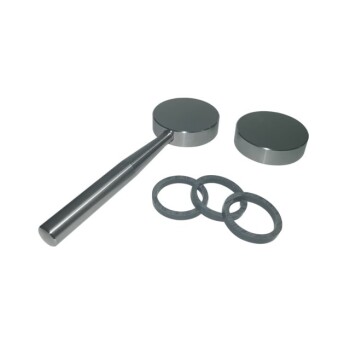A precious metal analyzer, specifically an XRF (X-ray Fluorescence) analyzer, operates by utilizing the principle of X-ray fluorescence.
This technology is crucial for determining the composition of precious metals and alloys.
It helps in identifying gold plating or other coatings.
It also assesses the value of precious metal samples based on their chemical composition and market prices.
The analyzer is non-destructive, allowing for analysis of samples of any shape and size without causing any damage.
4 Key Points Explained: How Does a Precious Metal Analyzer Work?

1. Components of an XRF Precious Metal Analyzer
- X-ray Generator: This component generates a high-energy X-ray beam that is directed onto the sample to be analyzed.
- Sample Area: The sample is placed in this area where the X-rays interact with it.
- Fluorescence X-ray Detector: This measures the energy and intensity of the fluorescent X-rays emitted by the sample.
- Data Processing System: This system records and analyzes the data from the detector, generating the chemical composition analysis results.
2. Principle of Operation
- The X-ray generator emits a high-energy X-ray beam that irradiates the sample.
- When the X-rays interact with the sample, they cause the atoms in the sample to emit secondary (or fluorescent) X-rays.
- These fluorescent X-rays are characteristic of the elements present in the sample.
- The fluorescence X-ray detector measures the energy and intensity of these emitted X-rays.
- The data processing system analyzes these measurements to determine the elemental composition of the sample.
3. Advantages of XRF Precious Metal Analyzers
- Rapid Analysis: The analysis can be completed in a few seconds, improving work efficiency.
- Non-Destructive: The sample is not damaged or altered during the analysis process, which is crucial for precious or non-renewable samples.
- Versatility: Suitable for various sample types, including solids, liquids, and gases.
- High Accuracy and Reliability: The analysis results are highly accurate and reliable, meeting the requirements of scientific research and industrial applications.
4. Applications of XRF Precious Metal Analyzers
- Precious Metals Recycling: Accurately analyzes and identifies the purity and concentration of recycled or recovered precious metals.
- Jewelry Industry: Used for authenticity identification, purity analysis, and karat value testing of gold jewelry.
- Pawnshops and Quality Inspection Agencies: For identifying the purity of precious metals and gold and silver jewelry.
- Industrial Catalysts: Monitoring the concentration of precious metals in various industrial processes, such as in the recovery of automobile three-way catalysts.
5. Specific Models and Their Capabilities
- Benchtop Gold Analyzer (XRF 200): Offers rapid and precise assessment of karat or gold content, serving quality control, pricing, and practical utilization needs.
- Handheld Precious Metal Analyzer (XRF990): Utilizes advanced ceramic packaged microfocus X-ray tube and high-performance semiconductor detector to quickly and accurately test the concentration of precious metals in jewelry and other materials.
In summary, an XRF precious metal analyzer is an essential tool for accurately determining the composition and purity of precious metals and alloys.
Its non-destructive nature, rapid analysis capabilities, and high accuracy make it a versatile and reliable choice for various industries, including jewelry, recycling, and industrial catalysts.
Continue exploring, consult our experts
Discover the precision and efficiency of KINTEK SOLUTION's XRF precious metal analyzers—perfect for your lab's needs. With rapid, non-destructive analysis, and unmatched accuracy, our analyzers elevate your research and industrial processes. To explore our cutting-edge technology and elevate your operations, contact our experts today and experience the KINTEK advantage. Don't miss out on the highest standard in analytical equipment—reach out now!














